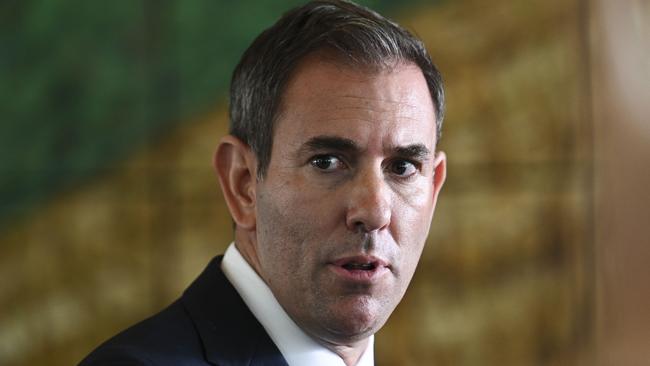Budget to reveal future deficits will be Made in Australia
Jim Chalmers has signalled that future budgets will prioritise growth at the expense of balanced budgets as the once-in-a-generation inflation challenge fades.

Jim Chalmers has signalled boosting growth will trump keeping the nation’s finances in the black beyond 2023-24, with “substantial” new investments under the Made in Australia policy to hit the bottom line in the later years of the May federal budget.
The Treasurer at Parliament House on Monday said he was “still aiming at a second surplus” in this financial year, and signalled there would be additional cost of living support for households and further help for students via HECS relief, while Western Sydney “would be a big priority in the budget”.
“While inflation is lingering, there is a premium on the second surplus if we can get there. But in the later years of our budget strategy, you can imagine a much more focused emphasis on growth, and growth takes investment,” Dr Chalmers said.
He rubbished concerns that the Made in Australia would add to inflation, saying the criticism “assumes wrongly that all of the investment that we are contemplating hits the economy at once at the front end”.
“What we’re talking about is a long term plan, because these are long term opportunities.”
Australian Chamber of Commerce and Industry chief executive Andrew McKellar said businesses he had spoken with were broadly supportive of a long term Made in Australia goal, but that there were far more urgent issue of the crippling cost of gas and energy, which in the past week has triggered the failure of the country’s only polythene producer, Qenos.
“We are fully sympathetic to the objective of growing future industries in Australia and continuing to develop sovereign manufacturing capability,” Mr McKellar said.
“But we are losing industrial capacity we don’t need to lose right now, and we are strangling many of the smaller and medium-sized businesses with uncompetitive tax arrangements and red tape, and making it harder for them to employ people.”
Economists said there was little hope of a third surplus in 2024-25, and expressed concerns that the government in its pivot towards boosting growth would abandon attempts to achieve balanced budgets over time.
Deloitte Access Economics partner Stephen Smith said his latest estimates had economic growing slowing from 2.1 per cent last year, to 1.3 per cent in 2024 – which outside the pandemic would be the weakest performance since the recession of the early 1990s.
While the return of real wage growth this year would be a welcome development, it would only be the first, small step to undoing the damage to living standards wrought by the great inflationary outbreak of 2022, Mr Smith said, with Australian workers’ real wages not estimated to return to 2021 levels until 2031.
In that context, Mr Smith said “we think this is the calendar year that policy makers need to shift from containing inflation to boosting growth, so that pivot does need to happen lest we find ourselves back in that pre-Covid environment of just limping along at a very low level of economic growth”.
Mr Smith said vulnerable households would still need more support, and that the early impact of any changes under the Made in Australia act should be aimed at creating an environment for growth, such as tax incentives for businesses and additional support for education and training.
But he was worried that future budgets would be less focused on fiscal discipline.
“The risk is that we have deficits as far as the eye can see after this financial year, and I think we do need to get far more realistic about the future fiscal position. We need to change the tax and spending mix, but also the way we raise the revenue.”
KPMG chief economist Brendan Rynne said fading corporate and income tax revenue following the end of employment and commodity price booms would make it harder to achieve surpluses from the next financial year.
“Added to that, obviously, is a government agenda focused on spending to achieve policy outcomes ahead of next year’s election. You are getting pressure on both sides of the ledger, which means the likelihood of a surplus, all else being equal, is going to be more challenging,” Dr Rynne said.
“The economy absolutely needs to be focused on growth. The question is whether the government is the right organisation to choose where that growth is going to come from, and arguably that answer is ‘no’.”
Government spending was “too high and wasn’t budging” at 27 per cent of GDP, against 23-24 per cent leading up to the pandemic.
“If they determined that 27 per cent of GDP is the level of government expenditure required, then they need to readjust tax settings. And that readjustment is not just soaking the rich, it requires wholesale reform such that those people that are getting government services getting provided to them, are also contributing in a reasonable way as well,” Dr Rynne said.






To join the conversation, please log in. Don't have an account? Register
Join the conversation, you are commenting as Logout